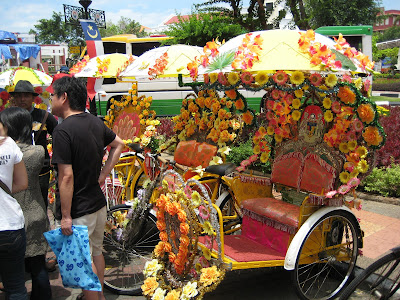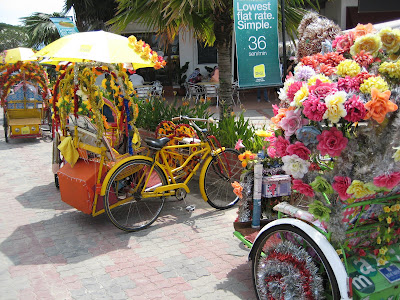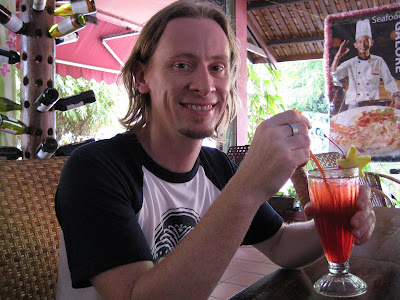Monday, December 22, 2008
Sunday, December 21, 2008
 Xmas and New Year in Sydney
Xmas and New Year in SydneyI can't wait. It's been over 18 months since I've been in Australia, and, as you can imagine, the differences to Malaysia are substantial :).
I don't think I've mentioned it previously, but we're going to be moving back to Sydney in late February, my contract in Malaysia is finishing up, and while there are many things that I enjoy and will miss about KL, it sure is going to be good to go home.
Posted by
Glenn
at
2:34 pm
1 comments
![]()
Monday, December 08, 2008
SAID HANRAHAN by John O'Brien
"We'll all be rooned," said Hanrahan,
In accents most forlorn,
Outside the church, ere Mass began,
One frosty Sunday morn.
The congregation stood about,
Coat-collars to the ears,
And talked of stock, and crops, and drought,
As it had done for years.
"It's looking crook," said Daniel Croke;
"Bedad, it's cruke, me lad,
For never since the banks went broke
Has seasons been so bad."
"It's dry, all right," said young O'Neil,
With which astute remark
He squatted down upon his heel
And chewed a piece of bark.
And so around the chorus ran
"It's keepin' dry, no doubt."
"We'll all be rooned," said Hanrahan,
"Before the year is out."
"The crops are done; ye'll have your work
To save one bag of grain;
From here way out to Back-o'-Bourke
They're singin' out for rain.
"They're singin' out for rain," he said,
"And all the tanks are dry."
The congregation scratched its head,
And gazed around the sky.
"There won't be grass, in any case,
Enough to feed an ass;
There's not a blade on Casey's place
As I came down to Mass."
"If rain don't come this month," said Dan,
And cleared his throat to speak -
"We'll all be rooned," said Hanrahan,
"If rain don't come this week."
A heavy silence seemed to steal
On all at this remark;
And each man squatted on his heel,
And chewed a piece of bark.
"We want an inch of rain, we do,"
O'Neil observed at last;
But Croke "maintained" we wanted two
To put the danger past.
"If we don't get three inches, man,
Or four to break this drought,
We'll all be rooned," said Hanrahan,
"Before the year is out."
In God's good time down came the rain;
And all the afternoon
On iron roof and window-pane
It drummed a homely tune.
And through the night it pattered still,
And lightsome, gladsome elves
On dripping spout and window-sill
Kept talking to themselves.
It pelted, pelted all day long,
A-singing at its work,
Till every heart took up the song
Way out to Back-o'-Bourke.
And every creek a banker ran,
And dams filled overtop;
"We'll all be rooned," said Hanrahan,
"If this rain doesn't stop."
And stop it did, in God's good time;
And spring came in to fold
A mantle o'er the hills sublime
Of green and pink and gold.
And days went by on dancing feet,
With harvest-hopes immense,
And laughing eyes beheld the wheat
Nid-nodding o'er the fence.
And, oh, the smiles on every face,
As happy lad and lass
Through grass knee-deep on Casey's place
Went riding down to Mass.
While round the church in clothes genteel
Discoursed the men of mark,
And each man squatted on his heel,
And chewed his piece of bark.
"There'll be bush-fires for sure, me man,
There will, without a doubt;
We'll all be rooned," said Hanrahan,
"Before the year is out."
Posted by
Glenn
at
3:13 am
1 comments
![]()
Sunday, December 07, 2008
Tuesday, December 02, 2008
A smile to light up the night sky
.. Tonight outside my window:
Planets Venus and Jupiter are forming the eyes. Directly below, the crescent moon forms a happy mouth.
Yeh i know, crappy photos, it went behind a cloud before I could get my tripod prepped.

Posted by
Glenn
at
2:08 am
0
comments
![]()
Robot soldiers to get a kinder software side

WASHINGTON: The US military is planning to build robot soldiers that would not be able to commit war crimes.
The army and the navy have hired experts in the ethics of building machines to prevent the creation of an amoral Terminator-style killing machine. By 2010 the US will have spent $4 billion ($6.1 billion) on research into "autonomous systems", the military jargon for robots, on the basis that they would not succumb to fear or the desire for vengeance that afflicts front-line soldiers.
A British robotics expert has been recruited by the navy to advise on building robots that would not violate the Geneva Conventions.
Colin Allen, a scientific philosopher at Indiana University, has just published a book summarising his views titled Moral Machines: Teaching Robots Right From Wrong.
He said: "The question they want answered is whether we can build automated weapons that would conform to the laws of war. Can we use ethical theory to help design these machines?"
Pentagon chiefs are concerned by studies of combat stress in Iraq that showed that a high proportion of front-line troops supported torture and retribution against enemy combatants. Ronald Arkin, a computer scientist at Georgia Tech university, who is working on software for the army, has written a report that concludes that robots, while not "perfectly ethical in the battlefield" can "perform more ethically than human soldiers".
He said that robots "do not need to protect themselves" and "they can be designed without emotions that cloud their judgment or result in anger and frustration with ongoing battlefield events".
Airborne drones are already used in Iraq and Afghanistan to launch air strikes and robotic vehicles are used to disable roadside bombs and other improvised explosive devices.
But this generation of robots are all remotely operated by humans. Researchers are now working on "soldier bots", which would be able to identify targets and distinguish between enemy forces and soft targets, like ambulances or civilians. Their software would be embedded with rules of engagement.
Dr Allen applauded the decision. "It's time we started thinking about the issues of how to take ethical theory and build it into the software that will ensure robots act correctly rather than wait until it's too late."
Posted by
Glenn
at
2:01 am
0
comments
![]()
Sunday, November 30, 2008
Sunday, November 23, 2008
Kono Pizza
Kono Pizza at Pavillion for lunch Saturday.
I think it's one of those quirky japanese ideas, but it's actually a rather practical and delicious one. The chicken and mushroom was pretty good, but the beef one with the olives (beef capriccio?) was better.
Posted by
Glenn
at
9:06 pm
1 comments
![]()
Thursday, November 20, 2008
Gmail introduces themes
.. here are a few choice examples, there are quite a few more to choose from (31 in total so far).
Aah a pleasant surprise this morning.. Google has introduced themes into Gmail.
Looks like they're gradually rolling it out account by account (as they do).
Some very nice stuff here.
Very cool.
Thanks Mr Google :)
Posted by
Glenn
at
2:05 pm
1 comments
![]()
Monday, November 17, 2008
Creative & unusual lamp designs





I've always had a thing for lamp design, so it makes me way too happy to see these designs.
.. Check em out.
Posted by
Glenn
at
2:47 pm
0
comments
![]()
Sunday, November 16, 2008
Oblong's g-speak: the 'Minority Report' OS brought to life
If you've been waiting for that Minority Report-style interface to really come to fruition, you can finally exhale.
One of the science advisors from the Steven Spielberg film -- along with a team of other zany visionaries -- has created an honest-to-goodness, real-world implementation of the computer systems seen in the movie.
Dubbed g-speak, the mind bending OS combines "gestural i/o, recombinant networking, and real-world pixels," to deliver what the creators call "the first major step in [a] computer interface since 1984."
Posted by
Glenn
at
12:15 am
0
comments
![]()
Wednesday, November 12, 2008
Tuesday, November 11, 2008
A few weeks ago we went to my girlfriends cousins wedding (and yes, I was the only whitey) and amongst much delicious food was these wonderful pau;
Posted by
Glenn
at
1:58 am
0
comments
![]()
held at:
.. Yes, Restaurant Drunk Cat. I think asian restaurants might be well advised to avoid references to pets, drunk or otherwise in their list of possible names.
I wonder what their other options were to consider this the best choice?!
Restaurant strung-out rodent?
Restaurant vomiting gecko?
.. The mind again, it boggles.
Posted by
Glenn
at
1:49 am
0
comments
![]()
.. I'm really loving this album at the moment. Check it out if you like droney 60's inspired psychedelic folk pop. I know i do.
Posted by
Glenn
at
1:46 am
0
comments
![]()
Monday, November 10, 2008
Few of us would care if our house keys appeared in a photograph of the family picnic posted on the internet.
But we should be concerned because advances in digital imaging and optics means any photograph of a key posed a potential security threat, Stefan Savage, a computer science professor at the University of California, warns.
Professor Savage and two of his PhD students have developed a software program called Sneakey that can clone a key in "two to three minutes" after analysing a digital photograph.
The algorithm is so sophisticated it easily copes with the low-resolution mobile phone images routinely posted on social networking sites such as MySpace and Facebook.
"The software looks at the key, adjusts the image for any rotations or distortions, then produces a string of numbers that is appropriate for that key," Professor Savage said.
"Those numbers are fed into a key-cutting machine and it makes a perfect copy.
Professor Savage, 39, said his team at the University's Jacobs School of Engineering in San Diego found "thousands" of images of keys inadvertently posted on the photo-sharing site Flickr.
They also used a camera fitted with a telephoto lens to photograph and duplicate a set of keys on a cafe table from a distance of more than 60 metres.
Far from being unique, the bumps and valleys on a conventional key can be "completely described" using a five- or six-digit number, he said.
"The design of the keys we use today is 150 years old and the world has changed."
As a result, Professor Savage believes we should protect our keys in the same way we protect the code to our debit card.
Sneakey runs on an ordinary personal computer and uses key-cutting hardware that is readily available in Australia.
The University of California team is keeping the code secret, but Professor Savage admits anyone with a basic knowledge of programming and computer vision techniques would be able to reproduce it.
He believes the "keyless" locking systems used on modern cars will eventually become the standard for all security applications. Until then, you might think twice before posing for a happy snap with your keys dangling from your belt.
.. from smh
Posted by
Glenn
at
11:37 am
0
comments
![]()
Wednesday, November 05, 2008
Every few years, I become aware of 'batches' of coincidence in my life. I'm happy to report that I'm currently mid-batch :)
On Sunday night I found myself thinking about 2 friends, one in Sydney who I haven't spoken to in over 6 months, and another Malaysian friend who i work with everyday. His job isn't bad (at least not much worse than the rest of us) but i found myself feeling that he was going to resign.
Monday morning rolls around, and not only did the Australian friend who I haven't spoken to in 6 months ping me to say hello, but the Malaysian friend tells me he's resigned!
Only tonight my internet connection drops out and I call the tech support people. They ask me some details about my account, a principal one involving the word 'firefly'. 2 minutes after getting off the phone I'm taking out the rubbish and just outside my door I see something flashing on the ground.. and y'know what it was?
Only the first ever firefly that I have ever seen.
Aah I love coincidence.
Anyone have any similar stories? Anyone? Anyone? Bueller?

Posted by
Glenn
at
2:27 am
0
comments
![]()
Sunday, November 02, 2008
KUALA LUMPUR: Much to the joy of the public, a new signboard bearing the name "Jalan Alor" replaced the Jalan Kejora signboard on Thursday in Bukit Bintang by the Kuala Lumpur City Hall (DBKL).
The new signboard was put up after Kuala Lumpur mayor Datuk Ab Hakim Borhan announced on Oct 29 that the previous road name would be retained after Federal Territories Minister Datuk Seri Zulhasnan Rafique intervened.
In a statement yesterday Zulhasnan urged DBKL to refer matters concerning change of road names to the ministry in future to avoid similar controversies.
“Jalan Alor is not only popular in Malaysia but also all over the world.
“I understand the people’s sentiment over the initial decision for the change to Kejora and I hope the hawkers on Jalan Alor will press on cleanliness,” he said.
Two weeks ago DBKL replaced the old Jalan Alor signboard with Jalan Kejora which created a huge public outcry that caught the attention of the Federal Territories Ministry.
Bukit Bintang MP Fung Kui Lun said Jalan Alor was a brand name for over 50 years to both locals and foreigners and the decision to change it would have caused confusion.
“This is what the people want and I think it is fair to retain the name, everyone is happy,” he said.
Posted by
Glenn
at
4:59 pm
0
comments
![]()
Monday, October 27, 2008



The Oracle concept watches by Designer Andy Kurovets mixes time with Chinese philosophy.
The philosophy in particular is I Ching and it is a symbol system used to identify order in chance events. You can read about it more over here.
Andy adds a hexagram generator into the watch so that you can generate your own future. It is rather 'confusion' and would require an understanding of I Ching.
Posted by
Glenn
at
4:36 pm
0
comments
![]()
Thursday, October 23, 2008
Within just four years, most Australians will be able to drive an electric car and recharge it at special plug-in points at home, the office or shopping centres.
The mass use of electric cars moved a giant step closer to reality on Thursday, with power company AGL and finance group Macquarie Capital signing an agreement with international group Better Place to provide infrastructure to support the environmentally-friendly vehicles.
Under the agreement, Macquarie will raise $1 billion to build an electric-vehicle network in Melbourne, Sydney and Brisbane, and AGL will power it with renewable energy.
Better Place, established by American entrepreneur Shai Agassi, has designed the infrastructure model, which is already being rolled out in Israel and Denmark.
Mr Agassi said under the agreement, by 2012 the three major Australian cities will each have a network of between 200,000 and 250,000 charge stations where drivers can recharge their electric cars.
These are likely to be at home, in businesses, car parks and shopping centres, he said.
In addition, there will be some 150 switch stations in each city and on major freeways, where electric batteries can be automatically replaced in drive-in stations similar to a car wash.
"We call it a ubiquitous charging network across the cities," Mr Agassi said in Melbourne.
"It's a massive infrastructure project ... and that means new jobs for Australians."
Drivers will pay to recharge their cars through various power supply agreements, similar to mobile phone contracts, where consumers choose the rate that best reflects their car use.
Mr Agassi said the deal was an integral step, as people would only buy electric vehicles if the infrastructure was in place to support them.
While Renault-Nissan is already manufacturing an electric-only car, Mr Agassi said he hoped the agreement would encourage Australia's car manufacturers to develop their own versions.
The Victorian government has established a working group to examine fuel-efficient vehicle technology with the state's car manufacturers, with a particular focus on developing the first generation of electric vehicles.
"The Victorian government supports any initiative that will have positive outcomes in reducing emissions in the transport sector and I welcome this innovative approach to help make broad adoption of electric vehicles in Australia possible," Premier John Brumby said.
Better Place is also in discussion with federal and local governments about the rollout of the infrastructure.
Head of global development, Marshall Towe, said they hoped to strike an agreement that allowed them to install their infrastructure across the country without having to seek permission from each local area, similar to the deployment of the national cable network by Telstra.
Mr Agassi said it was up to Australian governments to determine how they would encourage consumers to turn to electric cars, such as through tax incentives or free power for the first purchasers.
"It's more a question for the government for how quickly they want the tipping point (towards electric cars) to happen," he said.
"Every government decides what they want to do. We believe that Australia, looking at all the alternatives, will pick the right mix for Australia."
Mr Agassi said they would look at introducing the infrastructure in Adelaide and Perth after 2012.
Posted by
Glenn
at
2:04 pm
0
comments
![]()
Wednesday, October 22, 2008
India launches moon mission in Asian space race

Scientists have better maps of distant Mars than the moon where astronauts have walked. But India hopes to change that with its first lunar mission.
Chandrayaan-1 - which means "Moon Craft" in ancient Sanskrit - launched from the Sriharikota space centre in southern India early Wednesday morning in a two-year mission aimed at laying the groundwork for further Indian space expeditions.
Chief among the mission's goals is mapping not only the surface of the moon, but what lies beneath. India joined what's shaping up as a 21st century space race with Chinese and Japanese crafts already in orbit around the moon.
The United States, which won the 1960s race to send men to the moon, won't jump in this race with its new lunar probe until next spring, but it is providing key mapping equipment for India's mission.
As India's economy has boomed in recent years, it has sought to convert its new found wealth - built on its high-tech sector - into political and military clout and stake a claim as a world leader. It is hoping that a moon mission - coming just months after it finalized a deal with the United States that recognizes India as a nuclear power - will further enhance that status.
"It is a remarkable technological achievement for the country," said S. Satish, a spokesman for the Indian Space Research Organization, which plans to use the 3080-pound (1723-kilogram) lunar probe to create a high-resolution map of the lunar surface and what minerals are below. Two of the mapping instruments are a joint project with NASA.
Until now, India's space launches have been more practical, with weather warning satellites and communication systems, said former NASA associate administrator Scott Pace, director of space policy at the George Washington University.
"You're seeing India lifting its sights," Pace said.
To date only the US, Russia, the European Space Agency, Japan and China have sent missions to the moon.
While much of the technology involved in reaching the moon has not changed since the Soviet Union and the U.S. did it more than 4 decades ago, analysts say current mapping equipment allows the exploration of new areas, including below the surface.
In the last year, Asian nations have taken the lead in exploring the moon. In October 2007, Japan sent up the Kaguya spacecraft. A month later, China's Chang'e-1 entered lunar orbit.
Those missions took high resolution pictures of the moon, but aren't as comprehensive as Chandrayaan-1 will be or NASA's upcoming half-a-billion-dollar Lunar Reconnaissance Orbiter, Pace said. The most comprehensive maps of the moon were made about 40 years ago during the Apollo era, he said.
"We don't really have really good modern maps of the moon with modern instrument," Pace said. "The quality of the Martian maps, I would make a general argument, is superior to what we have of the moon."
NASA has put probes on Mars' frigid polar region, but not on the rugged poles of the moon. Yet the moon's south pole is where NASA is considering setting up an eventual human-staffed lunar outpost, Pace said.
The moon's south pole is "certainly more rugged than where Neil Armstrong landed. It's more interesting. It's more dangerous," Pace said. "We need better maps."
And while the moon race in the 1960s was a two-country sprint between the United States and the USSR, more countries are involved this time. China, in particular, has been forging ahead in space.
Beijing sent shock waves through the region in 2003, when it became the first Asian country to put its own astronauts into space. It followed that last month with its first spacewalk.
More ominously, last year China also blasted an old satellite into oblivion with a land-based anti-satellite missile, the first such test ever conducted by any nation, including the United States and Russia.
While this is India's first space expedition beyond Earth's orbit, the head of India's space agency believes it can quickly catch China, its rival for Asian leadership.
"Compared to China, we are better off in many areas," Indian Space Research Organization chairman G. Madhavan Nair said in an interview with India's Outlook magazine this week, citing India's advanced communication satellites and launch abilities.
India lags behind only because it has chosen not to focus on the more expensive manned space missions, he said. "But given the funds and necessary approvals we can easily catch up with our neighbor in this area."
The mission is not all about rivalry and prestige. Analysts say India stands to reap valuable rewards from the technology it develops and, according to Pace, it already shows increased confidence in difficult engineering and quality control.
"Each nation is doing its own thing to drive its research technology for the well-being of that nation," said Charles Vick, a space analyst for the Washington think tank GlobalSecurity.org.
"Traditionally, for every dollar put into space research, we get that much more back," he said.
India is also collaborating closely with other countries on the mission.
Of the 11 instruments carried by the satellite, five are Indian, three are from the European Space Agency, two from the US - including radar that can search for ice under lunar poles - and one from Bulgaria.
Beyond 3-D mapping the moon and scanning for mineral deposits, the $US80 million ($117 million) mission will test systems for a future moon landing, the Indian space agency said.
India plans to follow this mission with landing a rover on the moon in 2011 and eventually a manned space program, though this has not been authorised yet.
And the Indian space agency was already dreaming of more.
"Space is the frontier for mankind in the future. If we want to go beyond the moon, we have to go there first," said Satish.
Posted by
Glenn
at
2:43 pm
0
comments
![]()
LONDON: Buses emblazoned with advertisements declaring "there's probably no God" will soon be travelling through the streets of London after the prominent atheist Professor Richard Dawkins agreed to help pay for them.
Campaigners say the messages will provide a "reassuring" antidote to religious ads that "threaten eternal damnation".
Professor Dawkins, the author of The God Delusion, said: "Religion is accustomed to getting a free ride - automatic tax breaks, unearned 'respect' and the right not to be 'offended', the right to brainwash children.
"Even on the buses, nobody thinks twice when they see a religious slogan plastered across the side. This campaign to put alternative slogans on London buses will make people think - and thinking is anathema to religion."
The advertising campaign, which could be plastered across as many as 60 buses for a month if just £11,000 ($27,000) is raised, was triggered by a blog posting. Those behind the project are confident they will raise enough money to pay for two sets of 30 bendy buses to travel through the capital in January bearing the atheist slogan: "There's probably no God. Now stop worrying and enjoy your life."
Posted by
Glenn
at
11:42 am
0
comments
![]()
The site where the city of Malacca stands today was the center of Malaccan history.
It was the capital of the Malaccan Sultanate and was the centre of the Malay world in the 15th and the 16th century after the Malays moved over from Sumatra and it was the most developed part of the Malay Peninsula before it fell to the Portuguese in 1511.
Centuries of colonization by the Portuguese, Dutch and the British as well as development of Straits Chinese (Peranakan) culture have influenced the architecture of the town.
.. And we went there recently for a couple of days :).
The trishaws are a great way of seeing the town, and not really that expensive either.
Some of the wiring on these things is incredible.. check the above, those are interior light switches. Most, if not all of the trishaws has a car battery or similar in the back that they use to power the pounding music (a mishmash of pounding techno and 80's love songs) and this here is the control centre of it all.
It was really hot, so we treated ourselves to a couple of cocktails before lunch. I'm liking Singapore Slings very much. I had a few of them, just to make sure.

Replica Portuguese ship. Interesting 6/10; refuge from the heat 9.5/10.
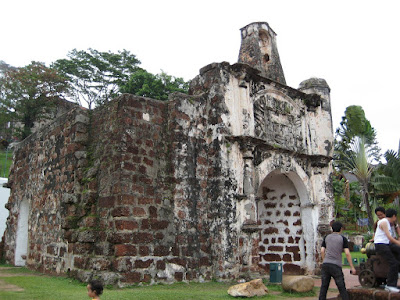
A' Formosa - built by the Portuguese in 1511 as a fortress to safeguard their settlement



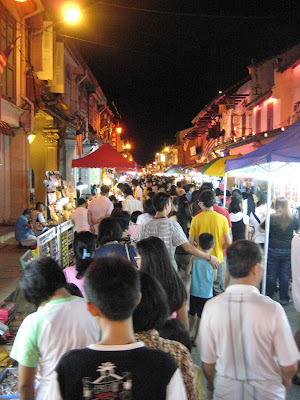
Night Markets on Jonkers Street

View from a tri-shaw

Oh course, how could we not have the famous Malaccan Chicken Rice ball.
All in all, Malacca is an excellent way to escape from KL for a couple of days. Great food, friendly people, and more sights, sounds and novelties that you can poke the proverbial stick at.
High recommended. In fact, I'm going to go back soon.
Posted by
Glenn
at
2:05 am
0
comments
![]()










 Ninja
Ninja Desk
Desk Bus Stop
Bus Stop Terminal
Terminal Shiny
Shiny Team House
Team House Cherry
Cherry








